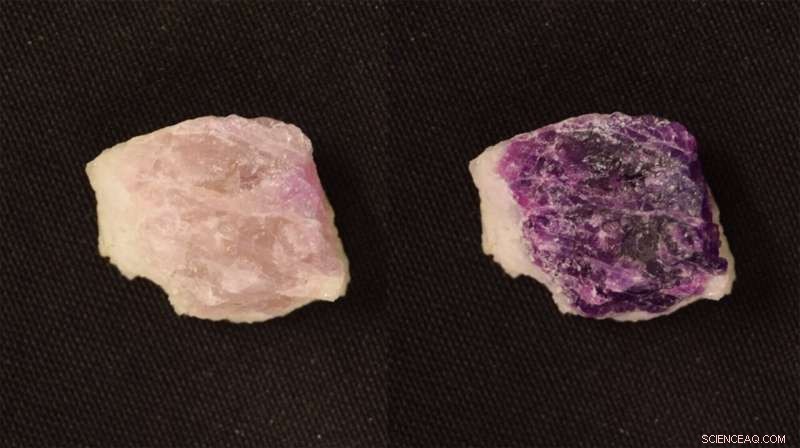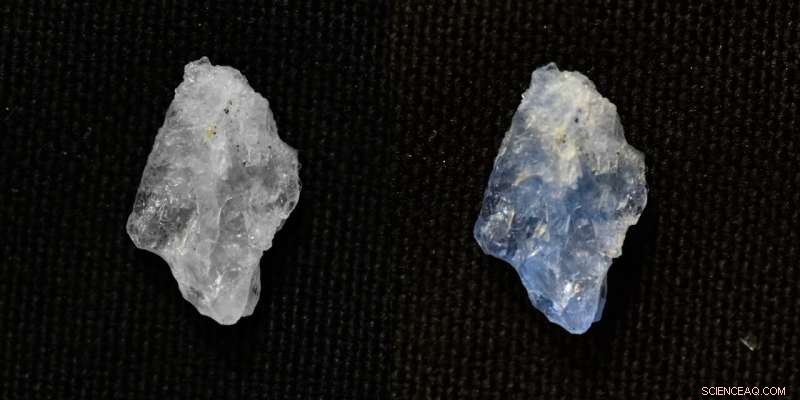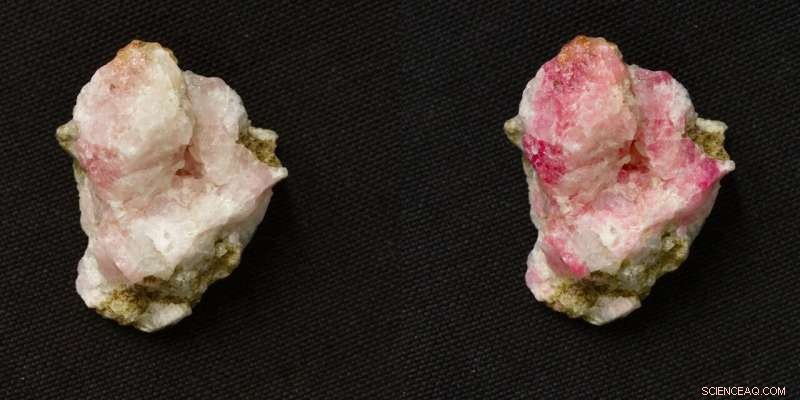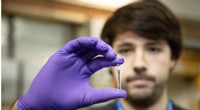Naturlig mineralsk hackmanit demonstrerer meget gentagelig farveændringsevne

Hackmanit bliver lilla under UV-bestråling, og farven falmer tilbage til hvid på få minutter under almindeligt hvidt lys. Denne prøve er fra Grønland. Kredit:Mika Lastusaari
Mens de undersøgte hackmanit, fandt forskerne ud af, at det kan ændre farve ved udsættelse for UV-stråling gentagne gange uden at blive slidt. Resultaterne viser, at den billige hackmanit, som er nem at syntetisere, også har høj holdbarhed og flere anvendelsesmuligheder.
En forskergruppe ved universitetet i Turku, Finland, har undersøgt og udviklet hackmanittens egenskaber i næsten et årti. Applikationer som personlig UV-overvågning og røntgenbilleder er udviklet baseret på hackmanites evne til at ændre farve.
Hackmanite ændrer sin farve fra hvid til lilla under UV-bestråling og vender til sidst tilbage til hvid, hvis ingen UV er til stede. De strukturelle træk, der muliggør sådanne gentagne ændringer, har hidtil været uklare. Nu, efter at have undersøgt tre naturlige mineraler – hackmanit, tugtupit og scapolite – har forskerne fundet svaret.
Disse farveskiftende mineraler er uorganiske naturmaterialer, men der er også organiske forbindelser, kulbrinter, som kan ændre farve reversibelt på grund af eksponering for stråling. Disse kulbrinter kan dog kun ændre farve et par gange, før deres molekylære struktur nedbrydes. Dette skyldes, at farveændringen involverer en drastisk ændring i strukturen, og at gennemgå denne ændring gentagne gange til sidst bryder molekylet.
"I denne forskning fandt vi for første gang ud af, at der faktisk også er en strukturel ændring involveret i farveændringsprocessen. Når farven ændres, bevæger natriumatomer i strukturen sig relativt langt væk fra deres sædvanlige steder og vender derefter tilbage. tilbage. Dette kan kaldes 'strukturelt åndedræt', og det ødelægger ikke strukturen, selvom det gentages et stort antal gange," rapporterer professor Mika Lastusaari fra Institut for Kemi ved Universitetet i Turku, Finland.

Hvid scapolite bliver blå under UV-bestråling. Farvningen og tilbagevenden til hvid efter fjernelse af UV-kilden tager kun et par sekunder, fordi atomer i strukturen bevæger sig korte afstande. Scapolite er et ret almindeligt mineral. Denne prøve er fra Afghanistan. Kredit:Sami Vuori
Forskere beviste, at hackmanites evne til at veksle mellem hvide og lilla former er meget gentagelig
Ifølge professor Lastusaari skyldes holdbarheden den stærke tredimensionelle burlignende overordnede struktur af disse mineraler, som svarer til den, der findes i zeolitter. I rengøringsmidler gør den burlignende struktur for eksempel zeolit i stand til at fjerne magnesium og calcium fra vand ved at binde dem tæt inde i burets porer.
"I disse farveskiftende mineraler sker alle processer forbundet med farveændringen inde i porerne i zeolitburet, hvor natrium- og kloratomerne opholder sig. Det vil sige, at den burlignende struktur tillader atombevægelse inde i buret, samtidig med at selve buret bevares. intact. This is why minerals can change color and revert back to their original color practically indefinitely," Doctoral Researcher Sami Vuori explains.
Previously, it has been known that scapolite changes color much faster than hackmanite, whereas tugtupite's changes are much slower.
"Based on the results of this work, we found out that the speed of the color change correlates with the distance that the sodium atoms move. These observations are important for future material development, because now we know what is required from the host structure to allow the control and tailoring of the color change properties," says Doctoral Researcher Hannah Byron.
"There were no characterization methods available for the research on color changing minerals, which is why we have developed new methods by ourselves. However, it is difficult to interpret the results unambiguously based on experimental data alone. In fact, we could not have reached the present conclusions without strong support from theoretical calculations, since only the combination of experimental and computational data shows the whole picture. We owe a great many thanks to our collaborator Professor Tangui Le Bahers and his group, who have developed and advanced suitable computational methods to such detail and accuracy that would not have been possible just a few years ago," says Lastusaari.

Tugtupite is a rare mineral, which turns pink when exposed to UV radiation. The return back to white takes several hours, because it requires large atomic movements. This sample is from Greenland. Credit:Sami Vuori
Hackmanite has amazing potential for applications
The Intelligent Materials Research Group at the Department of Chemistry of the University of Turku, led by Lastusaari, has long conducted pioneering research on materials with light and color-related properties, especially on hackmanite. They are currently exploring numerous applications for hackmanite, such as possibly replacing LEDs and other light bulbs with the natural mineral and using it in X-ray imaging.
One of the most interesting avenues that the researchers are currently exploring is a hackmanite-based dosimeter and passive detectors for the International Space Station, intended to be used to measure the radiation dose uptake of materials during space flights.
"The strength of hackmanite's color depends on how much UV radiation it is exposed to, which means that the material can be used, for example, to determine the UV index of Sun's radiation. The hackmanite that will be tested on the space station will be used in a similar fashion, but this property can also be used in everyday applications. We have for example already developed a mobile phone application for measuring UV radiation that can be used by anyone," explains Sami Vuori.
The paper was published in June in the PNAS tidsskrift. + Udforsk yderligere
Naturligt mineral hackmanit muliggør ny metode til røntgenbilleddannelse
 Varme artikler
Varme artikler
-
 Pesticid, der er dødeligt for bier, kan nu let opdages i honningProfessor Janusz Pawliszyn forvandlede sin græsplæne til en vildblomsteng for at tiltrække bier. Kredit:Janusz Pawliszyn Et almindeligt insekticid, der er en stor fare for honningbier, er nu effek
Pesticid, der er dødeligt for bier, kan nu let opdages i honningProfessor Janusz Pawliszyn forvandlede sin græsplæne til en vildblomsteng for at tiltrække bier. Kredit:Janusz Pawliszyn Et almindeligt insekticid, der er en stor fare for honningbier, er nu effek -
 Hummers underliv er lige så hårdt som industrigummiEn vildledende sej film beskytter hummerens mave, mens dyret smyger sig hen over den stenede havbund. Kredit:Massachusetts Institute of Technology Vend en hummer på ryggen, og du vil se, at unders
Hummers underliv er lige så hårdt som industrigummiEn vildledende sej film beskytter hummerens mave, mens dyret smyger sig hen over den stenede havbund. Kredit:Massachusetts Institute of Technology Vend en hummer på ryggen, og du vil se, at unders -
 Forskere øger varmen på smeltede metaller for at skabe fremtidige teknologierBryan Owens-Baird, en kandidatstuderende forsker fra Iowa State University, forbereder sig på at studere en af sine prøver, en pulveriseret forbindelse af fosfor, silicium, og tin, med NOMAD -instru
Forskere øger varmen på smeltede metaller for at skabe fremtidige teknologierBryan Owens-Baird, en kandidatstuderende forsker fra Iowa State University, forbereder sig på at studere en af sine prøver, en pulveriseret forbindelse af fosfor, silicium, og tin, med NOMAD -instru -
 Æteriske oliekomponenter kan testes som lægemiddelkandidaterKredit:CC0 Public Domain Et forskerhold ved VIB-KU Leuven Center for Mikrobiologi og KU Leuven Biologisk Institut viste, at i modsætning til almindelig tro, de fleste komponenter i æteriske olier
Æteriske oliekomponenter kan testes som lægemiddelkandidaterKredit:CC0 Public Domain Et forskerhold ved VIB-KU Leuven Center for Mikrobiologi og KU Leuven Biologisk Institut viste, at i modsætning til almindelig tro, de fleste komponenter i æteriske olier
- Mars InSight-lander til at skubbe oven på muldvarpen
- Truede planter på Filippinerne
- Ud for den amerikanske kyst, Tanger -øen forsvinder under vand
- SpaceX udsætter californisk satellitopsendelse på grund af vind
- Invasive og indfødte marskgræsser kan give lignende fordele for beskyttede vådområder
- En Alaskan-dommer netop genindsatte et offshore-boreforbud - Heres hvorfor det er tilfældet


